History of Gangotri - Interesting Story About the Creation of Gangotri Dham
Home » Gangotri Dham »
Temple History:
 Located in the quaint, scenic and picturesque town of Gangotri, as the name suggests the temple is dedicated to goddess Ganga and is visited by pilgrims from all over the Indian subcontinent as a part of their Chota char dham yatra of Uttarakhand. Standing majestically on the banks of the holy river Bhagirathi the word Gangotri is a combination of two words that describe the event i.e. Ganga + Uttari, which roughly translates into Ganga descending. The holy town is a centre of attraction during the pilgrimage season and numerous pilgrims flock together here to offer their prayer to the presiding deity there.
Located in the quaint, scenic and picturesque town of Gangotri, as the name suggests the temple is dedicated to goddess Ganga and is visited by pilgrims from all over the Indian subcontinent as a part of their Chota char dham yatra of Uttarakhand. Standing majestically on the banks of the holy river Bhagirathi the word Gangotri is a combination of two words that describe the event i.e. Ganga + Uttari, which roughly translates into Ganga descending. The holy town is a centre of attraction during the pilgrimage season and numerous pilgrims flock together here to offer their prayer to the presiding deity there.
Submerged Shivling of Gangotri – also popular as Jalmanga Temple and located close to the main dham shrine of Gangotri the interesting fact about this place is that when the water levels rises up the linga is completely submerged and out of sight for its visitors. It can only be witnessed and is open for visitation during the time when the water level goes down substantially. This place is frequented by pilgrims since it is believed to mark the spot where Lord Shiva had held the holy river Ganga in his matted hair before sending it to the earthly realm.
Perched at a height of 3,042 metres above sea level all along the right bank of the holy river Bhagirathi this dham shrine is believed to have been constructed by the popular living lion of Nepal, Amar Singh Thapa in the 18th century, before which the temple was nothing but a small sacred shrine.
Mythologies behind River Ganga:
It has been believed that as per the Hindu mythological tales that goddess Ganga was an extremely beautiful, vibrant and free-spirited lady who is believed to have been taken birth from Lord Brahma’s water vessel or Kamandalu. There are two myths revolving around her birth:
- While washing the feet of Lord Vishnu, Lord Brahma had collected the remainder water in a water vessel after Lord Vishnu is believed to have freed the universe from Bali the demon while his rebirth as Vaman.
- Another belief is that Ganga had reincarnated in a human form and had married one of the ancestors of Pandavas of King Shantanu. She then gave birth to 8 sons, 7 of who were then unexplainably thrown into the river. The 8th son, Bheeshma was saved with the intervention of King Shantanu. Later on Ganga left him while Bheeshma became an extremely important figure in the epic of Mahabharat.
Winter Abode:
During the winter months of November to April, when the temple kapat shuts down for darshan, the presiding deity image is shifted to its winter home in Mukhwas which is also known as Mukhba. Situated in the scenic hill town of Harsil and located on the banks of the holy river Bhagirathi, Mukhba is perched at an elevation of 2,620 metres above sea level. Each year during the auspicious even of Diwali the idol of Goddess Ganga is brought down to Mukhba which is accompanied with vibrant processions and the Doli is carried along with an idol of the presiding deity. The music for this entire procession is given by the army band of Garhwal rifles who accompany the entire journey and keep the spirits of the pilgrims at an all-time high. When the ice is cleared and the day comes for the opening of the main dham shrine of Gangotri, this presiding deity is carried back with great zeal and enthusiasm back to its original place.
Gangotri Travel Tips:
- Being an extremely pious tourist destination, consumption of alcohol and non-vegetarian food items is prohibited.
- Even if you are travelling to Gangotri during the peak summer months, you will be facing the Himalayan chill. Be sure to carry ample woolen clothing items that will keep you warm and snug throughout the journey.
- Remember not to book your char dham tour packages during the monsoon months of july and August since the entire region during this time remains prone to unexpected landslides and avalanches and will put your holy pilgrimage at risk.
Best Time to Visit:
Summer (Best time to Visit) – The clearing of the ice and the weather witnesses a positive change during the month of march however the region still remains prone to snowfall. The temple kapat opens up for darshan during the month of April and goes on uninterrupted till June mid. The average temperature stays between 21 degree Celsius and 11 degree Celsius.
Monsoon – The monsoon months in this hilly region begins from the month of July and goes on till September. The yatra is suspended and discouraged for a while during these months owing to the bad and unpredictable weather conditions that cause sudden landslides in the region and makes the paths extremely dangerous and slippery.
Winter – The temple kapat shuts down for darshan with the onset of winter during the months of October to February. During this time the entire region remains clad in a thick blanket of snow and pilgrimage is shut down. The average temperature during this time stays between 1 degree Celsius and 5 degree Celsius.


Leave a Reply